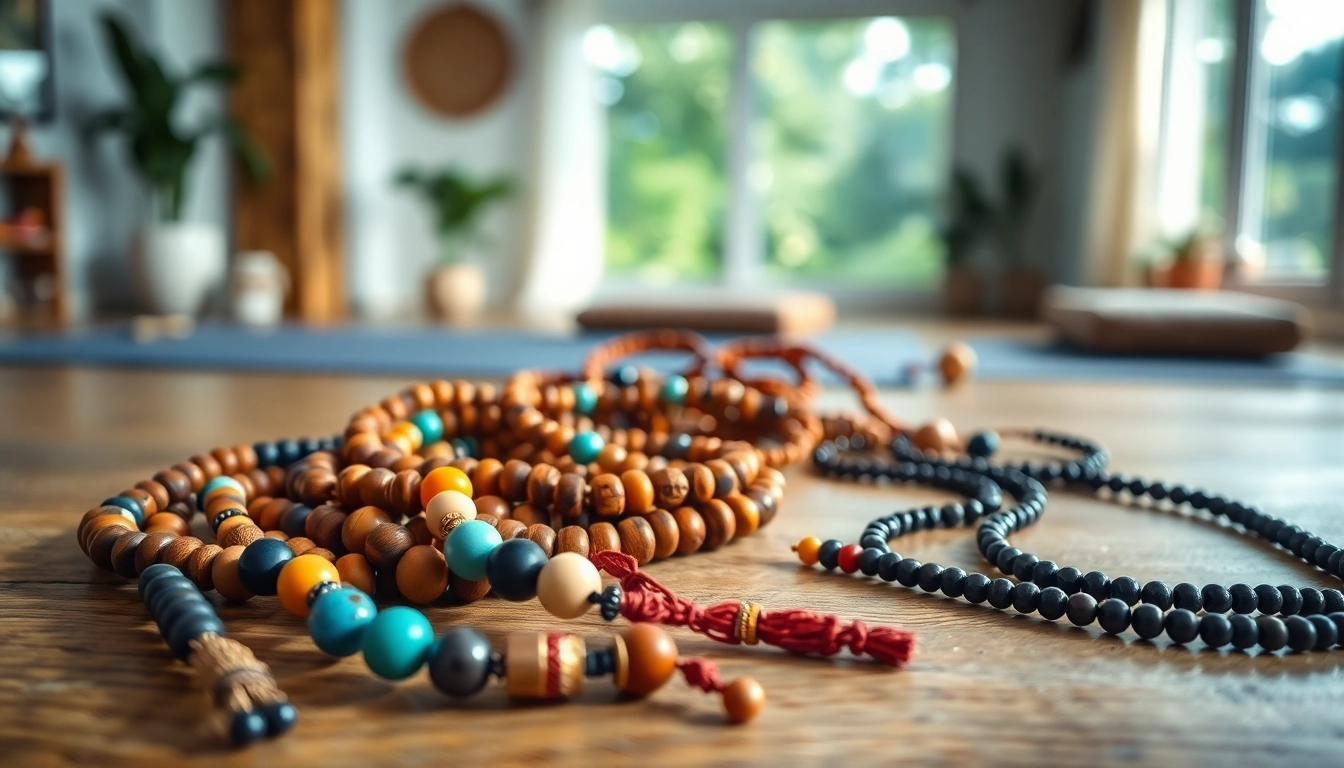Understanding Malas and Their History
Malas have been an essential part of various spiritual practices for centuries, serving as tools to aid in meditation and mindfulness. These beautiful strands of beads hold deep significance, connecting practitioners with their spiritual intentions and aiding in the focus during prayer or meditation. Whether you are new to the concept or looking to deepen your understanding, exploring the origins and meanings behind malas can deepen your personal practice.
The Origin of Malas
The term “mala” translates to “garland” in Sanskrit, and its roots can be traced back to ancient India. Originally, malas were used in Hinduism and Buddhism, often consisting of 108 beads arranged in a circular fashion, symbolizing the universe’s cosmic order. The number 108 has significant spiritual and mathematical importance, often linked to the heart chakra and the connection between the microcosm and macrocosm.
Throughout history, various cultures have embraced the mala. In Tibetan Buddhism, malas are commonly used for counting mantras during prayer, while in Hindu traditions, they serve as a device for meditation and spiritual focus. Over the years, the design of malas has evolved, incorporating various materials such as seeds, gemstones, and crystals, each believed to carry unique energies and healing properties.
How Malas are Used in Different Cultures
Different cultures have adapted the use of malas to align with their spiritual practices. In Buddhism, malas are crucial in rituals, often referred to as “buddha beads” or “prayer beads.” They are utilized to help practitioners keep track of mantra repetitions during meditation, allowing for a more profound connection to the sacred phrases being recited.
Hindus incorporate malas, particularly in personal worship (puja), and use them as an aid for devotion. Each bead serves as a tactile point of focus, allowing worshippers to immerse fully in their prayers while observing countable structure.
In addition to their use in religious contexts, malas have entered more mainstream consciousness, often seen as fashionable accessories. Many people wear malas to signify mindfulness and spiritual intention, illustrating that these tools transcend their traditional roots and embody modern wellness practices.
The Symbolism Behind Mala Beads
Beyond their functional use, each component of a mala has symbolic meaning. The individual beads represent different facets of life, experiences, or aspirations. The 108 beads traditionally symbolize the 108 human passions or defilements, while the guru bead—often larger or differently shaped—represents the spiritual teacher or guide, serving as a reminder of the significance of guidance on one’s spiritual journey.
Furthermore, the materials chosen for the beads contribute to their significance. For instance, sandalwood beads have calming properties while gemstones like amethyst can promote spiritual wisdom. Thus, practitioners often choose malas not only for their design but for the energetic properties attributed to the materials used, enhancing their meditation experiences.
Choosing the Right Malas for Your Practice
Selecting the right malas can enhance your meditation practice, allowing for optimal focus and intention setting. With a variety of styles, materials, and designs available, it’s essential to choose a mala that resonates with you personally.
Types of Malas Available
There is a vast range of malas available, each with unique characteristics:
- Traditional Handcrafted Malas: These are typically made from natural materials such as wood, stones, or seeds and are crafted with the intention to promote authenticity and connection to nature.
- Gemstone Malas: Often used for their healing properties, these malas incorporate various gemstones, each believed to benefit the user in specific ways—for example, rose quartz for love or fluorite for intuition.
- Seed Malas: Crafted from natural seeds, such as rudraksha, these malas are understood to possess unique spiritual qualities; rudraksha beads, in particular, are renowned in Hinduism for their protective and calming energies.
- Wrist Malas: These are compact versions of traditional malas, often worn as bracelets. They are suitable for those looking for a way to keep their meditation practice close during daily activities.
Factors to Consider When Selecting Malas
When choosing a mala, consider the following factors:
- Intended Use: Determining your primary use—whether for meditation, prayer, or as a fashion accessory—will guide your choice.
- Material: Reflect on the type of beads that resonate with your spiritual journey. Natural materials like wood or seeds offer grounding energies, while gemstones often provide personal healing properties.
- Length and Weight: The traditional mala is typically 108 beads long, but you may also find shorter versions. Select one that feels comfortable to hold in your hand during meditation.
- Design: Aesthetics are essential too; a mala that you are visually drawn to can enhance your spiritual practice, making you more likely to incorporate it into your daily routine.
Personalizing Your Mala Experience
Personalization can significantly enhance your experience with malas. Here are a few ways to infuse your mala with personal meaning:
- Intentional Setting: Before using your mala, take a moment to set a clear intention. This could be a specific mantra or affirmation you wish to focus on during meditation.
- Charging Your Malas: Many practitioners believe in the importance of “charging” or energizing malas. This can involve leaving your mala in sunlight or moonlight, or holding it while meditating with intention.
- Adding Charms: Some choose to attach charms or markers to their malas that hold personal significance, providing additional focus during meditation.
- Regular Cleanse: Just as one may cleanse crystals, soothing one’s mala is also essential. Regular cleaning is thought to clear out any negative energy and keep your intention pure.
How to Use Malas in Meditation
Understanding how to utilize malas effectively can transform your meditation practice, integrating mindfulness and intention into each session.
Counting Mantras with Malas
The primary function of malas is as a counting tool during mantra recitation. Typically, one starts at the guru bead and recites a mantra upon each bead, moving on to the next after completing the phrase. This method helps focus the mind, allowing for a deeper connection to the practice.
To optimize this process, find a comfortable position, focusing on your breath as you count. When reaching the guru bead, you may choose to reverse direction or complete the count, signifying the end of your session.
The Role of Intention and Mindfulness
Integrating intention and mindfulness into the practice enhances the effectiveness of using malas. Before using your mala, take a moment to reflect on what you wish to cultivate in your life—be it peace, abundance, or love. By holding this intention firmly in your mind during mantra repetition, you can deepen the spiritual connection.
Practicing mindfulness involves maintaining awareness of your thoughts, feelings, and the environment around you during your sessions. If your mind begins to wander, gently guide it back to your mantra and intentions. The repetitive nature of the beads aids this process, fostering steady concentration.
Integrating Malas into Daily Rituals
Incorporating malas into daily rituals can expand their role beyond formal meditation sessions. Here are a few suggestions:
- Morning Ritual: Start your day with a few mantra repetitions using your mala, focusing on intentions you wish to uphold throughout the day.
- Mindful Moments: Use your mala in moments of stress or anxiety—counting beads can provide a quick escape into mindfulness, helping to recenter your thoughts.
- Throughout Activities: Consider using your mala during other activities like walking, yoga, or even while commuting, allowing for an ongoing connection to your intentions.
Maintaining and Caring for Your Malas
Proper care is essential to ensure the longevity and active energy of your malas. Following a few key practices can keep your mala in the best condition possible.
Cleaning and Energizing Malas
Regular cleansing of your mala is crucial to remove accumulated energies from usage. Here are ways to clean your mala:
- Physical Cleaning: Gently wipe your mala with a soft cloth to remove dirt and oils from your hands.
- Energy Cleansing: Leave your mala under sunlight or moonlight to purify its energy; this is often believed to reset your mala’s connection to your intentions.
- Use of Sage or Incense: Burning sage or incense can also cleanse the mala, allowing the smoke to envelop the beads.
Storing Malas Properly
How you store your mala can affect its longevity and energy:
- Protective Storage: Avoid keeping your malas in areas where they can tangle or be damaged. Opt for a soft, dedicated pouch or box.
- Avoid Excessive Pressure: Storing it in a way that minimizes bending or crushing is essential, particularly for those made of delicate materials.
Repairing Damaged Malas
Despite your best efforts, malas may occasionally get damaged. Here’s how to approach repairs:
- Assess the Damage: Determine if individual beads need replacing or if the string requires repair.
- Seek Professional Help: Consider working with a professional who specializes in mala repairs or creating new malas.
- DIY Repairs: If you are familiar with the craft, you may opt to restring the mala, but this is generally recommended for experienced users.
The Benefits of Using Malas
Incorporating malas into your meditation and daily habits provides numerous benefits, from emotional to physical enhancements.
Emotional and Spiritual Benefits
The act of using malas promotes an emotional release, empowering individuals to express their inner feelings and cultivate peace within. Many report experiences of heightened spiritual awareness, appreciation, and connection to their intentions by engaging in mantra repetition.
Furthermore, allowing for a structured meditation can lead to a reduction in anxiety and stress, fostering emotional stability and resilience against daily challenges.
Physical Benefits During Meditation
The use of malas guides practitioners to maintain proper focus during meditation, which can lead to significant physiological benefits such as improved heart rate and blood pressure management. Regular meditation with malas can enhance the listener’s general health, improve sleep quality, and bolster the immune system by instilling a sense of calm.
Additionally, the repetitive actions involved in using malas help in developing a consistent meditation practice, contributing to ongoing physical and mental conditioning.
Connecting with Community Through Malas
Using malas can also build connections with communities. Whether through shared practices in yoga classes, spiritual circles, or online forums, malas serve as a bridge between like-minded individuals looking to deepen their spiritual practices together. This connection can foster a sense of belonging and support in one’s journey.
In summary, malas are more than mere accessories; they embody deep spiritual significance and transformative power. By understanding their history, choosing the right mala, learning to use them effectively, maintaining their integrity, and recognizing the benefits they offer, individuals can cultivate a richer and more mindful life.




